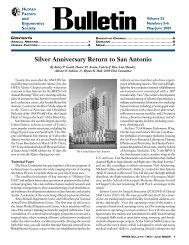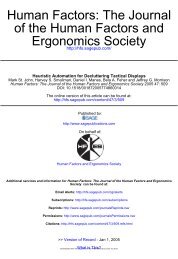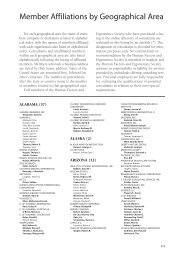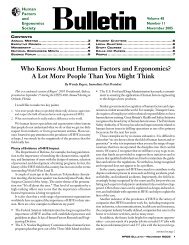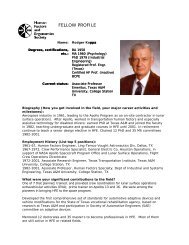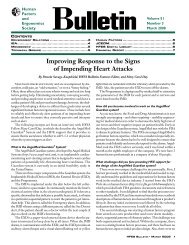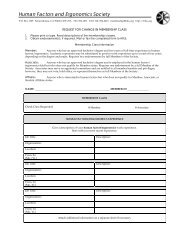Next Generation Air Transportation System Integrated Plan
Next Generation Air Transportation System Integrated Plan
Next Generation Air Transportation System Integrated Plan
You also want an ePaper? Increase the reach of your titles
YUMPU automatically turns print PDFs into web optimized ePapers that Google loves.
Chapter 7: Transformation Strategies<br />
As previously described, the roadmap is sub-divided into eight large<br />
transformation strategies that collectively are intended to create the<br />
<strong>Next</strong> <strong>Generation</strong> <strong>Air</strong> <strong>Transportation</strong> <strong>System</strong> (NGATS). <strong>Integrated</strong><br />
Product Teams (IPTs) will work to establish the detailed plans<br />
and execute these strategies. The following outlines how each IPT<br />
ties to objectives, its mission, transformation direction, and crossstrategy<br />
linkage to other IPTs. These outlines will become more<br />
detailed in the second edition of this plan. This will include refining<br />
the materials presented in outline form here, identifying the most<br />
significant technical obstacles, and pinpointing the research and<br />
development (R&D) activities necessary to overcome them.<br />
7.1 Develop <strong>Air</strong>port Infrastructure to<br />
Meet Future Demand<br />
<strong>Air</strong>port infrastructure must address the need to expand in a way<br />
that meets future capacity and provide a system that meets or<br />
exceeds user demand by integrating airport, airspace and air<br />
traffic management design, development, and deployment.<br />
Tie into Objectives<br />
• To provide sufficient capacity to satisfy demand<br />
• To provide sufficient resources to ensure that the development of<br />
new technology remains on track<br />
• To ensure the efficient flow of passengers through airport terminal<br />
facilities<br />
• To provide air traffic control and airport authorities with greater<br />
flexibility to match demand with capacity and, when necessary, to<br />
reduce congestion and travel delays<br />
• To provide infrastructure needed to protect the environment<br />
while sustaining growth<br />
IPT Mission<br />
To examine requirements and work for infrastructure and capacity<br />
development, through the expansion of existing airports and, in limited<br />
circumstances, the establishment of new airports to accommodate<br />
different levels and types of markets.<br />
Transformation Direction<br />
The predominant trend over the next two decades will be the expansion<br />
of existing airports to meet the forecasted increase in capacity demand.<br />
At the same time, new metropolitan areas will emerge that will<br />
prompt additional air capacity issues. National and regional airport<br />
planning will be facilitated with detailed analysis of needs to ensure<br />
the planning of sufficient capacity across the country.<br />
If airport infrastructure expansion cannot be accomplished using<br />
existing resources due either to physical or political constraints,<br />
alternate means will be employed to match demand with capacity<br />
to reduce or avoid congestion and travel delays. Such methods may<br />
include congestion pricing and other market-based approaches<br />
to demand management, administratively established limits on<br />
the frequency of operations, or hybrid measures incorporating the<br />
advantages of both.<br />
<strong>Plan</strong>ning efforts will be directed toward determining appropriate<br />
locations for infrastructure to accommodate alternative landing<br />
facilities such as unmanned aerial vehicles (UAVs), or support runwayindependent<br />
flight operations that may include rotorcraft and tilt<br />
rotor that might have mobility or economic growth benefits. Federal<br />
and local roles in the deployment and maintenance of infrastructure<br />
will be reviewed.<br />
Develop creative means to accelerate the deployment of capacity<br />
enhancing systems.<br />
Cross-strategy Linkage<br />
This IPT will coordinate its work with the following IPTs to fulfill<br />
its mission:<br />
• Establish an Agile <strong>Air</strong> Traffic <strong>System</strong><br />
• Establish an Effective Security <strong>System</strong> without Limiting Mobility<br />
or Civil Liberties<br />
• Harmonize Equipage and Operations Globally<br />
• Develop Environmental Protection that Allows Sustained<br />
Economic Growth<br />
• Establish a Comprehensive Proactive Safety Management<br />
Approach<br />
• Develop <strong>System</strong>-wide Capability to Reduce Weather Impacts<br />
7.2 Establish an Effective Security <strong>System</strong><br />
without Limiting Mobility or Civil Liberties<br />
Establish a global security system to ensure reservation-todestination<br />
security for travelers and the stream of commerce.<br />
Travelers and shippers will be confident that no undue security<br />
or health risks exist in the transportation system and movements<br />
and civil liberties are not unduly impeded by security measures.<br />
Tie into Objectives<br />
• Adapt to changing market forces<br />
• Ensure security efficiently serves demand and time<br />
constraints<br />
Joint <strong>Plan</strong>ning & Development Office 25




